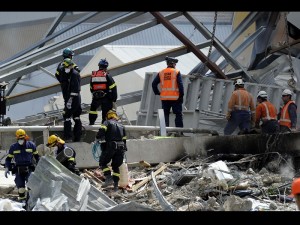Report: Building toppled by NZ quake substandard

Recovery operation personnel work on the destroyed CTV building in Christchurch, New Zealand after the city was hit by a 6.3 magnitude earthquake on Feb. 22, 2011. AP File Photo
WELLINGTON, New Zealand—A six-story building that collapsed and killed 115 people, including 11 Filipinos, during last year’s New Zealand earthquake did not meet construction standards, according to a government report released Thursday.
The report was contested by the building’s designer, which called it “technically inadequate.”
The Canterbury Television (CTV) building in Christchurch fell into a smoldering heap during the magnitude-6.1 earthquake on Feb. 22. It accounted for nearly two-thirds of the quake’s 184 victims.
New Zealand’s Department of Building and Housing found in its report that the CTV building didn’t meet minimum requirements when it was built in 1986 — and would fall far short of latest standards.
The report is the first to find construction flaws in a building that collapsed during the earthquake. Three previous reports of buildings, which at least partially collapsed, found that those buildings were built to requirements but failed due to the intensity of the quake.
Article continues after this advertisementThe findings could open the door for legal claims by victims’ families.
Article continues after this advertisementBrian Kennedy, whose wife Faye died in the CTV building collapse, said that family members would first likely want to hear from the designers, builders and inspectors at the inquiry and then “take it from there.”
He said the report helps give him at least some sense of closure.
“It gives me a feeling that I understand exactly what happened, how quick it happened, and that thank god it didn’t happen to other buildings,” he told The Associated Press.
The department concluded that load-bearing concrete columns were reinforced with insufficient steel, making them brittle, and that the columns’ asymmetrical layout made the building twist during the quake, placing extra strain on those columns.
The report didn’t specify who was to blame for the shortcomings — the architects who designed the structure, the construction company who built it, or the officials who inspected it — although there is probably plenty of blame to go around. An ongoing inquiry into the earthquake may find some more answers to those questions.
The department has handed its report to New Zealand police, for them to determine whether there is any criminal culpability.
Alan Reay Consultants, which carried out the building’s initial structural design, disagreed with the report.
“Personally I feel incredibly torn,” Reay said in a statement, issued immediately after the report came out. “I have huge empathy for the families waiting for answers, but these reports are technically inadequate … Some of the assumptions made in the reports are highly questionable.”
The report notes that drawings for the building fail to show a required gap between the columns and the beam panels that extended outward from those columns. The gap, which allows movement during an earthquake, was required to be 19 millimeters (3/4 inch) but in the drawings was only about half that.
The report also found that the drawings showed no reinforcing steel for the connections between some walls and floors. The omission was discovered in a 1991 review of the building for a potential buyer, the report said, which led to the installation of some steel connectors then. But the report concluded the additions were insufficient to make the building strong enough.